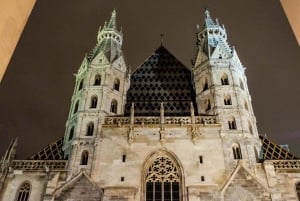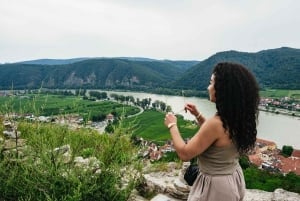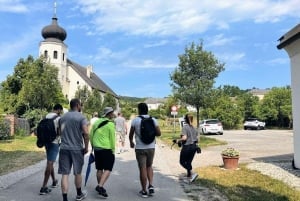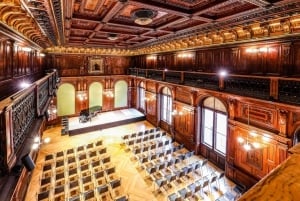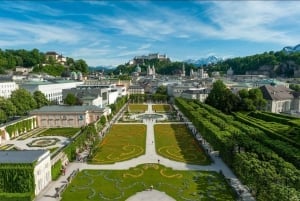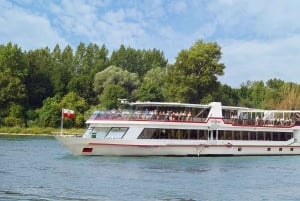Insider Tips about Vienna
Vienna is offering so many sights, museums and places of interest - you will be impressed by the beauty and choice. To help you making a pick, the My Guide Vienna team has come up with a whole section on TOP ATTRACTIONS and a walking tour section to make sure, the most important locations are introduced to you.
However, there is MUCH MORE to Vienna than that! And for this you need some INSIDE TIPS to guide you to the ultimate experience here in Vienna! We highly recommend you to have a look! There is something in there for you - guaranteed!
Horse drawn Carriages (Wiener Fiaker)
What is a Viennese "Fiaker"? Well, it is an elegant carriage, or coach, a charming coachman wearing a bowler hat and some gorgeous horses in front - the Fiaker serves as the most traditional and romantic mean of transport to get to know the heart of Vienna. Try it - you will love it!
Fiakerstations can be found at several spots around the city centre. This is where you hire them and negotiate the price for one trip. Mostly you find them next to the St. Stephan's Cathedral, in front of the Albertina Museum or in front of the Royal Palace (Hofburg) at the Michaeler Platz. It is a fantastic way to see the city from a different angle!
There are several trips possible ranging from 30min for €40, or a 90min grand tour for approx. €90. Be aware that a carriage takes a max. of 5 passengers. This is not cheap, but as we said, highly recommendable - especially if you ask the coachman to show you the more hidden side of Vienna, and to stay away from the classic route (you will most likely have seen most of it already). Most of them will show you their own favourites and tell anecdotes and stories about people, buildings and the city you will not likely hear anywhere else.
The name "Fiaker" originates from Paris: in the mid 17th century Parisians could hire carriages being stationed in "Rue St.Fiacre" - hence the name. Viennese imported that mean of transport to their town, where it became the inhabitants luxury "taxi" - in a way this still applies today, where Fiakers are hired for romantic trips, weddings, happenings, etc...
Viennese Coffeehouse (Wiener Kaffeehaus)
Unlike some other café traditions around the world, it is completely normal for a Viennese to linger alone for hours in a coffeehouse and to study the omnipresent newspaper. This is done as much by housewives, business people, students or even pupils who'd rather study here than at their home. Along with coffee, the waiter will serve an obligatory glass of cold tap water and during a long stay will often bring additional water unrequested, with the idea being that you are a guest who should feel welcomed and not pressured to leave due to other customers - yes, this is really true!
Waiters are dressed in dinner jackets or tuxedos in the typical Kaffeehaus, never casually. They are very proud of their position and job, which reflects in a distant and often cool approach to customers. Waiters rarely smile or chat with clients, they are there to make sure you are served well. One thing is important: although they expect to be tipped they would NEVER change their distant attitude to a more friendly approach just to make sure that they will get tipped - this is a question of pride for them. So do not expect chit chat with local waiters in the coffeehouses...
Why are coffeehouses so popular here? Well, in the late 19th and early 20th century leading Austrian contemporary writers became attached to the atmosphere of Viennese cafés and were frequently seen to meet, exchange and to even write while having coffee or other drinks. Literature composed in cafés is today commonly referred to as "coffeehouse literature", the writers thereof as "coffee house poets". The famous journal "Die Fackel" ("The Torch") by Karl Kraus is said to have been written in cafés to a large extent. Since then the coffeehouses are strongly engrained in Viennese culture and tradition.
The furnishings of a Viennese café can vary from plush interior, old fashioned, run down and comfy to art nouveau and stylish. The classic look includes Michael Thonet chairs and marble tabletops. Nearly all cafés provide small dishes like sausages, goulash and salads as well as desserts, cakes and tarts, like Apfelstrudel, Milchrahmstrudel (delicious cake made of cottage cheese and milk) and Linzertorte.
In many classic cafés piano music is played in the evening and social events like literary readings are held. In the warmer months, customers can often sit outside, or in a little backyard - the Viennese call it "Schanigarten".
Vienna prides itself of its dozens of varieties of different coffees and keeps coffee drinking traditions alive...here's what you can order:
Kleiner Schwarzer: the Viennese version of espresso
Großer Schwarzer: double espresso
Kleiner Brauner: espresso with cream, often on the side
Großer Brauner: double espresso with cream
Melange: the most typical Viennese coffee. Similar to cappuccino but with the Viennese style espresso and more foamy milk in equal parts
Verlängerter: espresso with extra hot water, similar to a small Americano
Kapuziner: espresso with a dollop of whipped cream on top
Jugendstil - Art Nouveau in Vienna
Art Nouveau is an international philosophy and style of art, architecture and applied art - especially the decorative arts - which was most popular during 1890–1905. It is known in Vienna as "Jugendstil". Jugendstil was a reaction to the academic art of the 19th century, it is characterised by organic - especially floral and other plant inspired motives, as well as very stylised, flowing curvilinear forms. Art Nouveau is a philosophy of design according to which artists should work on everything from architecture to furniture and making art part of our daily life.
Vienna is full of Jugendstil and for those who love Art Nouveau it is the place to indulge and enjoy fantastic buildings, furnishings and museums. We have put a great art nouveau section together for you, mentioning the most important places, museums and shops decorated in this style.
The Vienna Secession Group at the Secession building is where the Vienna Art Nouveau movement started. It was formed in 1897 by a group of 19 Vienna artists and the first President was Gustav Klimt, Austrias most famous Jugendstil artist. Though the Jugendstil style is highly visible in many places in Vienna, we would suggest starting at the Secession building in the city centre and after that heading to some of the museums to check out other famous secessionists painters, such as Schiele, Moll, Moser, etc...we refer to our section of most important Jugendstil museums for further details.
Imperial Vienna - get a feel for it!
Vienna used to be the capital of the Austrian Hungarian Empire, the heart of the Old Continent, the centre of the Central and Eastern Europe. As much as the city today is modern and busy, you can still feel its history all around you when walking through the inner city, or strolling along the impressive Ring Road, or visit the sights listed in our Top Attractions section (Schönbrunn, Hofburg Palace, the Imperial Tombs, etc...). But the city's Imperial Splendor is much more than that! Viennese locals are proud of their "imperial background" and enjoy the grandeur of the former imperial life-style even today - it is very much part of the local daily life here.
A good place to enjoy a splendid meal in a truly imperial setting is the Palmenhaus Restaurant just next to the Imperial Palace. This art nouveau Greenhaus was built in the beginning of the 19th century and is an exquisite example of a Jugenstil Greenhouse, probably the most beautiful that was ever built (fantastic outdoor terrace during the warmer months!). Another excellent option, especially during the colder months, is savouring an extended Brunch in the truly marvelous Fine Art Museum Cafe every Saturday or Sunday morning (excellent in combination with a visit to the spectacular museum).
Imperial lifestyle also translates into craftmanship, style and tradition. While strolling through the centre of Vienna have a look at outstanding places where craft still is highly appreciated, i.e Demel for outstanding confectionary, or A.E. Köchert Jewellers for unique creations. Another "must do" for music lovers is the Sunday morning matinee concerts at the famous Musikverein, the place where the New Year's Concert takes place 1st of January.
Die Konditorei - Vienna's famous Confectioneries
Chocolate is loved all over the world. Vienna has been cultivating the art of chocolate and candy fabrication for centuries - and the results are unique and delicious! We have sampled the best ones here: so have a look - you will be astonished by the artistic approach to confectionery in this city...
One of the most famous confectioneries, already catering for the Habsburg dynasty in the 19th century is the Demel, an outstanding place to visit right in the city centre. You will be mind boggled by the sheer craftsmen skills of this confectionary master. Be aware that the place is usually pretty crowded, so getting a table to having a cup of coffee and taste some of the delicacies can be difficult - you can always stroll by the windows, if you want to have a look at how these "works or art" are produced. If you go there in the morning, you should be able to have a quiet look around.
Another insider tip is the chocolate artist Michael Diewald - every chocolate features something that relates to flowers. Confectionary here is exceptional, beautiful and delicious. He is located in the 6th district (Schmalzhofgasse 19). If you are into exotic tastes: he is also experimenting with wild fruits and herbs and produces awesome combinations of candies...ask for a sample - they are really generous!
Another great place is the Xocolat Factory (Servitengasse 5, 9th District) where you see the master himself working with chocolate (there is also a shop in the city centre, Freyung 2, 1st District). Everything here is created by hand - try the truffle varieties or the chocolate sticks - you will love them!
Last but not least to be recommended is a shop called Fruth at the Naschmarkt - our charming open market. The owner, Mr. Fruth, is sometimes in the shop - look for an elderly man wearing glasses. The place is charming and it looks like a "wonderland" candy store. Best to try here are the fruit tartlets, or other desserts to be bought in "finger food" size - a great take away to satisfy your "sugar attacks" after lunch. They also serve coffee, hot chocolate or sparkling wine in the shop itself, so if you are wandering around the Naschmarkt - this is a great place to stop and treat yourself to something exceptional!
Viennese Ice Cream
Enjoy our delicious ice cream in Vienna – you will hardly have tried better ice cream anywhere else...guaranteed!
Why is that? In the 19th century, Italian ice cream producers immigrated to Vienna and produced their magical ice cream, just like many of them did at home. A number of them, to the delight of the Viennese, settled here for good. Their descendants now run the ice cream business and many of the cool creations are still made following the ancient secret recipes.Today locals are convinced that their Viennese ice cream is far better than the Italian one, and...we tend to agree with them (being a real patriot).
Most of the ice cream parlours only open from spring till autumn, but some are so popular and delicious that they are open all year round. Our own favourites are:
Schwedenplatz Parlour, Hoher Markt Parlour, Tuchlauben Parlour - but check this website for other good alternatives:
Der Wiener Würstelstand - Vienna hot dog stands
The Viennese Würstelstand is the Austrian version of a traditional hot dog snack stand selling mainly sausages.
The Würstelstand was introduced in the 19th century as a source of income for war invalids during the Habsburg Empire. Today they are a fix integral part of Viennese city culture. It is truly THE place where all society levels meet for a quick bite and chat before hurrying on to their daily chores.
The best time to go for a sausage is the night...after a long night out...the later the evening, the better the taste. You can be sure to meet fellow night owls, no matter what age, what event they attended - they all are hungry, hang over and need some oily nourishment to suck up the alcohol!
Try the delicious "Käsekrainer" (spicy sausage filled with melted cheese), or "Burenwurst" (very spicy sausage) or "Frankfurter" (equivalent to Wiener sausages). You have a choice of hot mustard or sweet mustard to go with it as well as a slice of brown bread or a roll. The best Würstelstand in the city centre are located at the Albertina Museum or at Hoher Markt (Square).
The Vienna Boys Choir
Who has not heard of the famous "Vienna Boys' Choir"? It is one of the oldest boys' choirs existing in the world. For nearly five hundred years they have been a symbol of Austria and a fixed attraction in Austrian musical life. A number of famous musicians have emerged from its ranks. This is because their training is so good that it has produced numerous highly qualified vocalists, violinists, pianists and great composers (i.e. Joseph Haydn, Salieri - Mozart's erstwhile rival, and many others).
With the ending of the Habsburg monarchy in 1918, the choir gave up its old name and the imperial uniform (to which a sword belonged) and became the"Vienna Boys' Choir" since then they were regarded as Austria's "singing ambassadors". And, as ever, every Sunday the Vienna Boys' Choir sings solemn mass in Vienna's Hofburg chapel, continuing a tradition unbroken since 1498 - that is if they are not on world tour...
Tickets can be bought online, or at the Ticket Office near the Abertina Museum.
Trzesniewski - Viennese response to fast food!
This name is terribly tricky to pronounce for anyone that is not from Poland! Trzesniewski is an institution here in Vienna, often saluted as a city highlight in itself - and rightly so...What is it? Well, it is a miniature version of an open sandwich on dark brown bread. That's it, nothing more or less!
The toppings range from finely chopped ingredients that become a sort of spread made out of bacon, liver, herring, tomato, egg mayonnaise, etc...- we are sure that you will find something to your liking! Very important: you queue for your turn in front of a glass vitrine that displays the sandwiches, you walk along this vitrine and you pick/show the sandwiches you want, and at the end of the vitrine you collect your plate and you order your beverages (we recommend the Pfiff, a tiny 0,2l glass of draft beer - just the right size to wash the delicious sandwiches down!) for which you get a plastic token. This token you exchange for your beverage at the beverage stand nearby. Only then try to find a place to sit down - most locals stand at one of the many standing tables.
There is quite a bit of Trzesniewski outlets in Vienna now, but go to the one in the inner city - it is built in beautiful art nouveau style and has remained the same since beginning of the 20th century - really a feast for the eyes of art nouveau freaks!
Donauinsel - The Danube Island
The Donauinsel is a long, narrow island, in central Vienna, between the Danube river and the Danube channel. The island is 20km in length, but only 200 metres wide at is largest point. By most Viennese, the island is used as a great recreational area, especially during summer.
During the warm months of the year the Donauinsel boasts great beaches, with sports opportunities from rollerblading, cycling and swimming to canoeing. There is one beach which, in its beginning, felt so exotic that it was soon nicknamed the "Copa Cagrana" as a humoristic allusion to Rio de Janeiro's Copacabana: this is where you want to go.
During many summer evenings the Donauinsel has become the most popular place for outside party events with bars, restaurants and nightclubs. In summer there are lots of festivals and performances going on (check our events section) as it is THE place where huge stages can be built. Just note that it can get very crowded - so nothing for people who are looking for peace and quiet!
The Donauinsel is best accessed by metro which takes 7 minutes from the city centre. In addition, both tram and bus have their stops on the 5 bridges of the Danube. Private car traffic is prohibited on the entire island. Be aware that in the southern and northern parts of the island there are extensive (and free) nude beaches!
Ball season in Vienna
Nothing is more romantic than joining a fairy tale ball in Vienna! It happens exactly as you would picture it: the event takes place in one of Vienna's great palaces or halls, ladies will be wearing long evening gowns (min. ancle length), gentlemen mostly black tie and debutantes wear white ballgowns with long white gloves. You will be walzing and dancing away the whole evening (orchestras are always live the whole evening) till 5am. You can hitch a Fiaker (horse carriage) back home in the early morning and you will be enjoying an unforgettable evening in one of the most romantic cities of the world.
We cannot think of another place in the world where this tradition has survived since centuries. Balls in Vienna take place during the Carnival season - mid January to mid February and there is about 150 different ones taking place nearly every day during that period - and they are attended by mostly locals, they are meant for their entertainment, no matter what social status or background. Some balls are hosted by the city, others by occupations, churches, organizations etc. - all of them are open to the public. Each trade has their own ball - the firemen, the coffemakers, the artists, the lawyers, etc. Each of these balls are visited by the representativesof that occupation or organisation - it used to be a way of introducing the debutants to the "right surroundings". Of course, guests and visitors are always welcome, but generally people feel confortable among like-minded people.
Why is this happening in Vienna? Emperor Joseph II (1741-1790) preferred and respected the common man and did not care much for nobility. This is why he opened the ballrooms of his imperial palace for public balls for the common man. This started the tradition of public balls in Vienna - all of a sudden commoners had to learn how to dance and move in such grand surroundings - this is how the famous waltz was "born", a way in which the commoner felt comfortable dancing.
This whole tradition is really worth attending if you happen to be in Vienna at the right season - a unique experience only to be experienced in Vienna.


